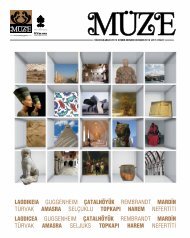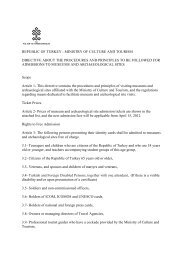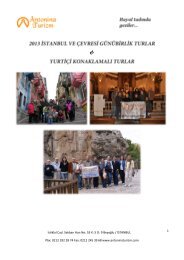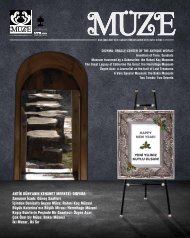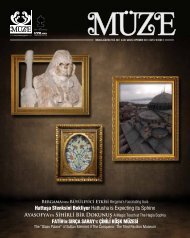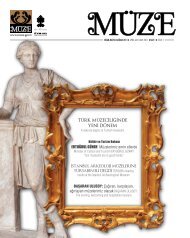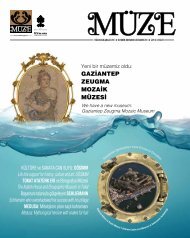Bir adam kendisine çocuk veren kadından ayrılmak isterse ... - MÜZE
Bir adam kendisine çocuk veren kadından ayrılmak isterse ... - MÜZE
Bir adam kendisine çocuk veren kadından ayrılmak isterse ... - MÜZE
You also want an ePaper? Increase the reach of your titles
YUMPU automatically turns print PDFs into web optimized ePapers that Google loves.
found evidence that permanent human settlements with religious ritual<br />
and social complexity existed even before the era of agriculture and<br />
animal domestication. Earliest signs of the existence of social hierarchy<br />
and individuality besides common values, significant original findings<br />
with respect to the era and human history characterize Körtik Tepe.<br />
Also were found clues as to the existence of a “Fatherly God” ritual in<br />
this area, as opposed to the Mother Goddess figure largely prevailing<br />
among Neolithic Age societies.<br />
Dr. AYDIN: What is the date of the earliest period reached at Körtik<br />
Tepe? Is Körtik Tepe an earlier settlement compared to Göbeklitepe?<br />
Prof. Dr. ÖZKAYA: Analytical methods and data were used in determining<br />
the date of each layer reached at Körtik Tepe. Although we did<br />
not yet secure exhaustive results concerning the deepest layers, we can<br />
affirm, based on C14 analyses, that the settlement is dated 10.400 BC.<br />
There are serious indications that it might be even older; but it would<br />
be too early to pronounce exact figures at this stage. There is no doubt<br />
that Körtik Tepe is an older settlement than Göbeklitepe. But beyond<br />
its oldness, the relevance of Körtik Tepe as a valuable source of science<br />
lies in its contribution to the perception of the cultural texture, to the<br />
understanding of the era and the origin of Mesopotamian cultures as<br />
nucleus of civilization.<br />
Dr. AYDIN: There is an argument that “salvage” or “rescue” excavations<br />
should not be undertaken at all and, that even if the area is filled by a<br />
dam reservoir, the site will remain intact under water. Is it possible to<br />
say that the Körtik Tepe mound was entirely uncovered and its excavation<br />
completed?<br />
Prof. Dr. ÖZKAYA: What is the benefit of an archive remaining under<br />
water and locked to everyone, particularly if that archive is a knowledge<br />
source of great interest to mankind? Dam projects are a threat to cultural<br />
heritage but, at the same time, it is incumbent upon us to translate<br />
this threat into a chance to salvage cultural and historical assets. I<br />
believe that Körtik Tepe excavations offer a great chance in that sense.<br />
Dr. AYDIN: Could the northern extension of the Fertile Crescent be the<br />
arena of history’s earliest settlement? How should Turkey approach this<br />
prospect?<br />
Prof. Dr. ÖZKAYA: There is no doubt that the Fertile Crescent is the<br />
core and birth place of mankind’s civilization. It is the home of the<br />
earliest worship rituals. Anatolia’s shareholding in this context was not<br />
recognized up until recently. However, it is now a proven fact that the<br />
Anatolian extension of the Fertile Crescent at the Upper Tigris Valley<br />
was home to some of the oldest human settlements in conjunction with<br />
the Fertile Crescent itself. Thanks to the archaeological work at Körtik<br />
Tepe and the other settlements of the same era in this geography, we<br />
learned that during approximately the same historical period, an even<br />
Körtik Tepe kazısında bulunan taş ve kemik aletler, takılar, figürlü ritüel taş objeler<br />
ve yontma taş kaplar (üstte). Körtik Tepe kazısından görünüm, yuvarlak planlı yapı<br />
(altta ortada) ve dibek taşı (altta sağda).<br />
Stone and bone tools, ornaments, figurative ritual objects and carved stone vessels<br />
(above). View of the Körtik Tepe excavation area, round-shaped structure (centre<br />
below) and stone mortar (below right).<br />
more developed human settlement<br />
concept based on a more<br />
advanced cultural background was<br />
present there.<br />
Dr. AYDIN: Why were the houses<br />
built in circular shape and which<br />
elements related to agriculture,<br />
stock breeding, storage methods<br />
and fishing did you discover at<br />
Körtik Tepe?<br />
Prof. Dr. ÖZKAYA: Körtik Tepe<br />
was a settlement established independently from agriculture and<br />
animal breeding; that constitutes its particular aspect which led to a<br />
revision of previous theories. Fishing was an indispensible source of<br />
nutrition. Our archeobotanic research revealed that Körtik Tepe people<br />
were picking a rich variety of vegetal foods from nature and water<br />
sources. Our archeozoological research revealed that hunting was a<br />
major nutrimental source for them as well. Nutrition habits were not<br />
in the form of a daily and communal supply, but based on individual<br />
meals and individual storage of foodstuffs, similar to developed human<br />
societies.<br />
Houses were built in circular shape as in the case of most of the known<br />
earlier human settlements. Living examples of that type of housing can<br />
be found today in African pastoral communities. That shape is apparently<br />
easier to build and offers a practical solution to upper structure<br />
construction problems.<br />
65



